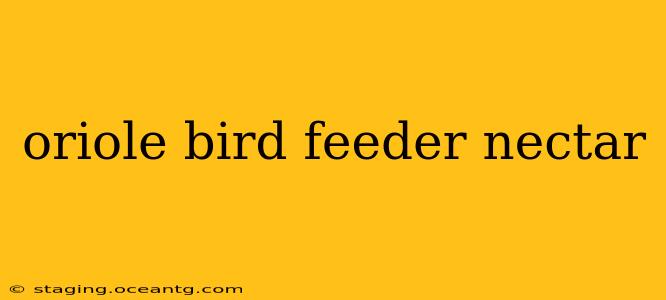Orioles, with their vibrant plumage and acrobatic feeding habits, are a delightful addition to any backyard. Attracting these beautiful birds often comes down to providing the right food source: a specialized nectar. This guide dives deep into everything you need to know about oriole bird feeder nectar, from recipes to homemade options and tips for attracting these stunning creatures.
What Kind of Nectar Do Orioles Like?
Orioles have a sweet tooth! They are particularly fond of nectars that are rich in sugar, offering a concentrated energy source. While they'll sample other foods, a high-quality oriole nectar is key to drawing them in consistently. Commercial oriole nectar blends are widely available, but many backyard bird enthusiasts prefer homemade options for cost and control over ingredients.
Can I Make Oriole Nectar at Home?
Absolutely! Making your own oriole nectar is simple, cost-effective, and allows you to control the ingredients. The most common recipe uses a simple ratio of sugar to water:
Simple Oriole Nectar Recipe:
- 1 part sugar (granulated white sugar is best)
- 4 parts water
Instructions:
- Combine sugar and water in a saucepan.
- Bring to a boil, stirring constantly until the sugar is completely dissolved.
- Let the mixture cool completely before filling your feeders. Never use hot nectar in your feeders.
Important Considerations:
- Avoid honey or other sweeteners: These can ferment quickly and harm the birds.
- Use only granulated white sugar: Other types of sugar may not dissolve properly or could be harmful.
- Don't add red dye: While many commercial nectars are dyed red, it's unnecessary and potentially harmful. Orioles are attracted to the sweetness, not the color.
How Often Should I Change Oriole Nectar?
Fresh nectar is crucial for preventing fermentation and keeping your feeders clean and healthy for the birds. Change the nectar in your feeders every 3-5 days, especially during warmer weather. Discard any nectar that looks cloudy, moldy, or smells fermented.
What is the Best Oriole Bird Feeder?
Orioles are acrobatic feeders, preferring feeders with perches that allow them to hang upside down while feeding. Look for feeders with:
- Multiple feeding ports: This allows multiple orioles to feed simultaneously, reducing competition.
- Strong perches: Orioles are heavier than hummingbirds and need sturdy perches.
- Easy-to-clean design: Cleaning is essential for preventing the spread of disease.
- Ant moats: These deter ants from crawling up the feeder and contaminating the nectar.
A variety of oriole feeders are available, including glass, plastic, and metal options. Choose the one that best suits your budget and aesthetic preferences.
What Other Foods Attract Orioles?
While nectar is a primary food source, orioles also enjoy:
- Oranges: Halve an orange and hang it from a tree branch.
- Grape jelly: Offer small amounts in a shallow dish or feeder designed for jelly.
- Mealworms: These are a great source of protein, especially for young birds.
Why Aren't Orioles Visiting My Feeder?
There are several reasons why orioles might not be visiting your feeder:
- Incorrect nectar recipe: Use the correct sugar-to-water ratio.
- Stale nectar: Change the nectar frequently.
- Poor feeder location: Place your feeder in a visible, shaded location away from predators.
- Competition: Other birds might be monopolizing the feeder.
- Lack of nearby trees or shrubs for cover: Orioles need shelter.
By following these guidelines and offering fresh, high-quality nectar in an appropriate feeder, you'll significantly increase your chances of attracting these vibrant and captivating birds to your backyard. Remember, patience is key! It may take some time for orioles to discover your feeder, but with consistent effort, you'll soon be enjoying their beautiful presence.
